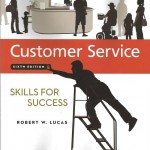 Preparing Customer Service Representatives
Preparing Customer Service Representatives
Preparing customer service representatives in the twenty-first century has become a prime strategic initiative in many organizations. That is because they face many challenges in achieving customer satisfaction, increasing customer retention and building customer loyalty that their predecessors did not experience. Technology continues to move at a break-neck pace, while the world economy shifts continually and causes companies to regularly re-evaluate how to best deal with competition. Add to this mix changing customer demographics with culturally-based needs, wants and expectations, and you have a potential prescription for failure.
Customer service representatives in the twenty-first century face many challenges in achieving customer satisfaction, increasing customer retention and building customer loyalty that their predecessors did not experience. Technology continues to move at a break-neck pace, while the world economy shifts continually and causes companies to regularly re-evaluate how to best deal with competition. Add to this mix changing customer demographics with culturally-based needs, wants and expectations, and you have a potential prescription for failure. The concept or practice of customer service is not new throughout the world. In fact, customers are the core of every business. As such, they should be the top priority for every organization. This includes internal  (employees) and external customers.
(employees) and external customers.
The concept or practice of customer service is not new throughout the world. In fact, customers are the core of every business. As such, they should be the top priority for every organization. This includes internal (employees) and external customers.
Successful managers recognize the need to reduce their customer churn rate and realize that if their customers go away, so do their jobs and organization. This is why truly customer-centric organizations strive to attract, hire, and retain the best qualified and capable customer service representatives (also known as customer care professionals) that they can find. They also pay competitive wages, provide industry-comparable benefits and continually train everyone in the organization. This training includes product and organizational culture information, as well as, the customer service skills necessary to effectively interact with all types of customers face-to-face and via technology.
In addition to effectively training employees, customer-focused organizations also ensure that all supervisors and managers have been trained in ways to effectively coach and mentor staff members. They also ensure that written policies and procedures are in place to provide guidance on expectations and processes so that all employees know what is expected of them. Also, to help employees deliver the best customer service possible, organizations must provide the most up-to-date software and equipment available, if it is required to help deliver stellar customer service.
 A final means of preparing customer service representatives for the challenges that they will likely face on any given day is to empower them to make decisions, when necessary to satisfy a customer or resolve and issue that arises.
A final means of preparing customer service representatives for the challenges that they will likely face on any given day is to empower them to make decisions, when necessary to satisfy a customer or resolve and issue that arises.
For ideas and strategies on better preparing customer service representatives and other employees for the tasks required in their jobs, check out two of my books – Please Every Customer: Delivering Stellar Customer Service Across Cultures, Customer Service Skills for Success and the American Management Association self-study course, How to Be a Great Call Center Representative. This latter resource results in a certificate of completion from the American Management Association once a final exam is taken and submitted to the association.
